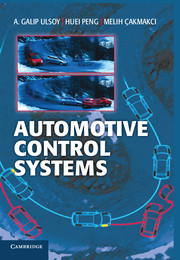Book contents
- Frontmatter
- Contents
- Preface
- Part I Introduction and Background
- Part II Powertrain Control Systems
- Part III Vehicle Control Systems
- 12 Cruise and Headway Control
- 13 Antilock Brake and Traction-Control Systems
- 14 Vehicle Stability Control
- 15 Four-Wheel Steering
- 16 Active Suspensions
- Part IV Intelligent Transportation Systems
- Appendices
- Index
- References
16 - Active Suspensions
Published online by Cambridge University Press: 05 June 2012
- Frontmatter
- Contents
- Preface
- Part I Introduction and Background
- Part II Powertrain Control Systems
- Part III Vehicle Control Systems
- 12 Cruise and Headway Control
- 13 Antilock Brake and Traction-Control Systems
- 14 Vehicle Stability Control
- 15 Four-Wheel Steering
- 16 Active Suspensions
- Part IV Intelligent Transportation Systems
- Appendices
- Index
- References
Summary
Automotive suspensions are discussed in Chapter 4 in connection with the vertical motion and ride properties of vehicles. A two-DOF quarter-car model was used, which is simple but sufficiently detailed to capture many of the key suspension-performance tradeoffs, such as ride quality (represented by sprung-mass acceleration); handling (represented by tire deflection); and packaging (represented by suspension stroke, also known as the rattle space). The performance index (see Chapter 4, Example 4.9) combines these three performance measures by assigning adjustable weights to the three performance terms.
Studies show that passive suspensions frequently are tuned to achieve good tradeoffs. Any improvement in one aspect of performance always is achieved at the expense of the deteriorated performance in another. The extra DOF offered by an active suspension could provide improved performance compared with a strictly passive suspension. The optimal design of a suspension for a quarter-car one-DOF model, as shown in Figure 16.1a (i.e., no unsprung-mass [wheel] dynamics), and the performance index, J1 = x21rms + ru2rms, has the structure shown in Figure 16.1b. Clearly, this structure, which includes a so-called skyhook damper, cannot be realized by the passive-suspension configuration shown in Figure 16.1c. Note that x1 in this one-DOF model represents the suspension stroke, r is a weight on control signal, and u is the control force, which also is directly proportional to sprung-mass acceleration. Clearly, an active suspension can provide performance benefits that cannot be achieved by using a strictly passive design (Figure 16.2). Furthermore, an active design can allow the performance to be user-selectable. For example, if a softer or a firmer ride characteristic is preferred by a user, the weights in the performance index used in the controller design can be changed (Hrovat 1988), leading to different controller gains and, consequently, different performance characteristics.
- Type
- Chapter
- Information
- Automotive Control Systems , pp. 287 - 306Publisher: Cambridge University PressPrint publication year: 2012
References
- 1
- Cited by

